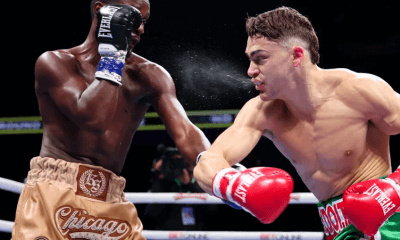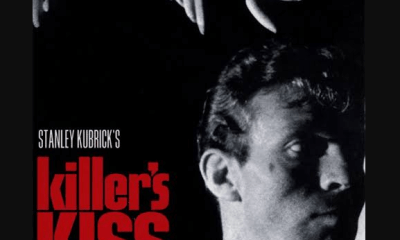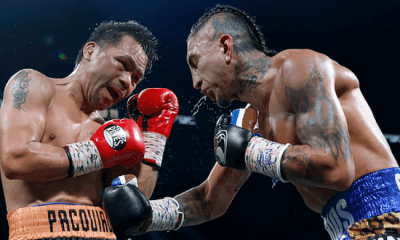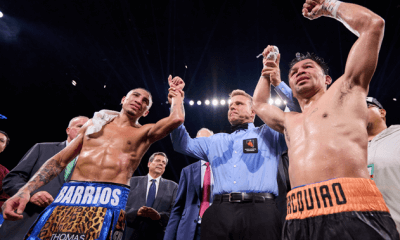Featured Articles
In Appreciation of: Holyfield Beating Tyson In 1996
In what was as complete a performance as one could imagine from a seemingly over-the-hill fighter, Evander Holyfield rewrote the script by dismantling Mike Tyson in eleven one-sided rounds at the MGM Grand Arena in Las Vegas on November 9th, 1996.
Considered shot , and with concerns lingering over his health due to a suspected heart condition, many believed Holyfield wouldn’t make it past the second round against Tyson. Had the fight ended in tragedy, which was widely feared because of Evander’s tremendous heart and never say die attitude, there would have been public uproar. It would be no exaggeration to suggest that there was more chance of the sacrificial lamb coming out on top during the slaughter than poor “old” Evander had of avoiding severe punishment at the hands of “The Baddest Man on the Planet”. Anyone who had seen Holyfield’s last two fights (a knockout loss to Riddick Bowe and a lackluster win over former middleweight Bobby Czyz) alongside Tyson’s (demolitions of Frank Bruno and Bruce Seldon inside of three rounds) had every right to believe that while one man should be at the very top of father time’s things to-do list, the other was returning to something like his scintillating best.
Shame on us.
Evander Holyfield’s deconstruction of “Iron” Mike Tyson forever sealed his fate as one of the greatest heavyweights to have ever lived. Though Holyfield gave all credit to God for the victory, his fearlessness, physical strength and immense self-belief were also huge factors in allowing him to triumph against the odds. Holyfield showed no fear whatsoever toward a man who made other heavyweights, far larger than himself, tremble in fear with little more than a passing glance. As high as a 25/1 underdog prior to the fight, Evander Holyfield defeated Mike Tyson not just physically, but psychologically too.
That said, lack of fear alone would not have been enough to get the job done against Mike Tyson. Neither would relying solely on superior physical strength for that matter. Hence, I’d like to highlight many of the understated boxing techniques that Evander Holyfield implemented on that unforgettable night in Vegas. For make no mistake, Tyson’s demise on that night had more to do with Holyfield’s superior craft than it did with anything else.
Before we delve any deeper into the fight, however, I think it’s important to take into acknowledge that Mike Tyson had declined somewhat as a fighter. Although it was never really mentioned at the time, looking back, I think it’s clear that Tyson was no longer operating on the same offensive or defensive level as he was under the tutelage of Kevin Rooney. Not only had the angular attacks in combination gone missing, but also the pre-emptive head movement as he was looking to get closer to his opponent. During his prime under Rooney (1985-1988) Tyson’s defense as he was advancing, which consisted of slips and double slips to the outside and inside of his opponent’s jabs and straights, allowed him to set up hard counters with either hand. Without Rooney is his corner, Tyson had become a little one dimensional, resulting in predictable straight line attacks that lacked creativity or thought.
Nevertheless, let’s not take anything away from Evander Holyfield. Mike Tyson was still generally considered the best heavyweight in the world at the time as his hand speed and explosiveness –still way above average for a heavyweight- as well as his concussive punching power were usually enough for him to come out on top against most opposition not going by the name of Evander Holyfield.
Although I’m personally of the opinion that by the time Mike Tyson and Evander Holyfield squared off, Tyson had all but forgotten about using his defense to set up his offense, he still frequently employed one of the many early signature attacks that were taught to him during the days of Cus D’Amato and Kevin Rooney. As Tyson looked to bridge the gap between himself and his opponent, he would often throw a half jab (jab feint) to create an opening for an overhand right or right cross –a variation on the cross counter.

Here’s a young Mike Tyson performing one of his signature attacks. As Tyson looks to enter into punching range, he performs a half jab followed by an overhand right. Here, Tyson’s non-committal, distance closing half jab has drawn out a response and created a perfect opening for his right hand over the top of his opponent’s jab.
Let’s take another look at Tyson’s crushing right hand preceded by a half jab.

Here again, we see Tyson closing in, using a half jab to set up his overhand right. Tyson’s slight level change along with a non-contact half jab help to create an opening for his right hand. Using the half jab as a set up also chambers his right hand, placing it into a cocked position.
Were it not for Evander Holyield’s tremendous set of whiskers, the fight may have been over the moment it started. As both fighters met in the center of the ring, Tyson quickly launched said attack, throwing a half jab before landing a huge right hand on the jaw of Holyfield.

As Tyson looks to enter, he throws a half jab, proceeded by an overhand right. In this instance, Tyson’s deceptive jab draws out a rear hand parry from Evander, resulting in Tyson’s overhand right traveling through the created opening and sending Holyfield stumbling toward the ropes.
With Holyfield weathering the early storm, Tyson soon realized that the man standing in front of him was a far cry from what he’d become accustomed to facing lately. Along with remaining undeterred after eating Tyson’s right hand early, there was another key moment that signalled why Holyfield was very different from anyone who Tyson had recently shared a ring with. Where most of Tyson’s opponents would back up in a straight line in attempting to avoid his sudden rushes, Holyfield had a contrasting outlook as to how to defense Tyson’s attack. Here is where we got our first glimpse of Holyfield’s superior counterpunching ability.

As Tyson throws a left hook, instead of distancing himself to avoid the blow, Holyfield blocks the hook using his right forearm, then immediately counters with a double hook (short left hook to the waistline then a left hook to the head). Notice how the low hook causes Tyson to lower his stance and bring his guard down which in turn opens up a target up top. This is the main reason behind lever punching. Also, notice how as Holyfield lands his double left hook, he immediately pivots on his lead foot, taking himself off the line off attack. This is how Holyfield ends up on the opposite side of the ring to where he started his combination from. Again, instead of backing up in a straight line, Holyfield is countering and turning Tyson.
Before we go any further, I’d like you to take a look at Tyson’s face in the last still of that sequence.

As Tyson is adjusting his shorts, his facial expression says a thousand words. Mike Tyson was the ultimate confidence fighter, a front runner. Having seen his right hand prove ineffectual and then having another attack easily diffused and countered within the opening moments of the fight, I believe Tyson began to show early signs of defeat. His smirk here is almost that of surprise. Doubt was already beginning to creep in.
As the fight progressed, Tyson continued to attack Holyfield in a straight line. There was little to no head movement, no ducking or slipping before entering, and apart from a moment when Tyson managed to land his signature right hook to the body followed by a right uppercut to the chin, which Holyfield took without really batting an eyelid, there were no signs of the combinations that made him one of the most unique heavyweights around. With Holyfield jabbing from the outside, moving laterally to avoid Tyson’s rushes, he then began to stand his ground more. Any time Tyson managed to breech Holyfield’s range, Evander would simply clinch and push Tyson off. You see, this is one of the biggest misconceptions that surrounds Mike Tyson. Although he advanced in a way that suggested he wanted to get inside at all costs, his best work was actually done on the way in. Apart from his right hook/right uppercut combination and left hook to the body in close, which, were always more effective against opponents who were a lot taller than himself, Tyson wasn’t the inside fighter everyone seems to think he was. As I’ve already mentioned, many of Tyson’s opponents thought the best way to fight him was to avoid his rushes by backing up. This was suicide, especially during his prime. Tyson’s sudden shifts and explosiveness were simply too much for those who moved off in a straight line. Those who did always found themselves on the very end of his punches. Evander Holyfield showed that by getting close to Tyson, and by not giving him his desired momentum, he wasn’t as dangerous.

Here’s a segment where Holyfield and Tyson are at close quarters. First, let’s look at Tyson’s body shape. His hands are chest height, his shoulders are square and his feet are parallel. Tyson’s balance, which is of the upmost importance during infighting, is severely compromised. By contrast, Holyfield’s rear leg is out behind, giving him far greater stability. His right glove is in a position to block against Tyson’s left hook and his body is chambered ready to deliver a left hook. Regardless of who was physically stronger, Holyfield’s infighting technique was simply better. At close quarters, it was Holyfield who had the advantage. Holyfield’s short hooks on the inside were a prominent weapon for him throughout the fight.
With each passing moment, as Holyfield’s confidence continued to grow, Tyson looked more and more a beaten man. With Holyfield controlling the fight, whether it was by jabbing from the outside or by landing shorts hooks on the inside, Tyson was slowly being broken down by a superior craftsman.
At the beginning of this analysis, I paid a lot of attention to Tyson’s half jab/right hand attack. The reason being that I believe the fight was quite literally won and lost on Tyson’s failure to land it, Holyfield’s ability to counter it, and Tyson’s inability to move away from it. Although Holyfield took Tyson’s right hand at the beginning of the fight, there’s no doubt that an accumulation of the same blow over the course of the fight would have eventually gotten Evander out of there. However, instead of looking to all out avoid the blow, Holyfield embraced it and used it as a way to trigger his counter right hand.

As Tyson moves in behind a half jab, Holyfield performs a rear hand parry, rolls with Tyson’s right hand, and counters with his own right hand.
Much in the same way as Juan Manuel Marquez recently treated Manny Pacquiao’s non-contact feint and jab (a precursor for his straight left) as a trigger for his own overhand right, Evander Holyfield did the same in this fight. As Tyson threw his non-contact half jab, Holyfield parried it anyway and treat it as a precursor for Tyson’s right hand. Although parrying is primarily a defensive measure, it can also be used to get your opponent’s timing down. Throughout the fight, Holyfield parried Tyson’s jab to trigger his counter right hand.

Once more, Tyson looks to attack by feinting with the jab to set up his right hand. Notice Holyfield’s rear hand in the first still. He’s already anticipating Tyson’s next move. As Tyson throws the jab, Holyfield is fully aware that the moment he parries, a right hand will be heading his way. As a result, he’s able to roll with the blow and counter Tyson with his own right hand. Notice also how Holyfield’s head is taken away from the centerline as he lands his counter right hand, thus eliminating any chance of Tyson countering back without having to punch across himself.
If any of you decide to watch the fight after this analysis, you may feel that Tyson is actually catching Holyfield clean every time he throws his right hand. However, what Holyfield is successfully doing is rolling in the same direction as the blow. This shouldn’t be confused with what Floyd Mayweather has made a career out of doing (rolling the blow off his shoulder). Rather, Holyfield is actually absorbing some of the blow. Instead of absorbing the full weight of it, however, Holyfield is turning his head in the same direction, taking away some of its weight, while chambering himself to come back with his right hand. It’s one thing to stand in front of Philip Ndou and roll with his punches, but standing in front of Mike Tyson and rolling with his right hand is another thing entirely.
Evander Holyfield’s counterpunching, more than anything else, continued to be the story of the fight.

Devoid of ideas, Tyson continues to load up with his right hand. Again, Holyfield’s rear hand parry is key. This time, instead of waiting on the right hand, Holyfield parries the jab, continues forward and intercepts Tyson’s right hand with his own short right hand. Although the blow is short and doesn’t appear all that damaging, Tyson’s forward momentum is doubling up its impact. No doubt, these are damaging counters from Evander.
Although Evander Holyfield will likely be remembered mostly for his unmatched heart and resiliency, this next sequence highlights just how calculating he could be in the ring.
Below we see a double counter from Holyfield.

As Tyson moves in again looking to land his right hand, Holyfield parries his jab and counters with his own jab. Because Tyson’s momentum carries him forward as he’s trying to land his right hand, Holyfield moves inside the arc of the blow and counters again with a right hand to the body. Although this sequence happens in an instant, seeing it frame by frame shows you just how quick Holyfield’s mind was working in there.
While I was watching the fight back, although I was in awe of Holyfield’s counterpunching ability, I couldn’t help but wonder how much Mike Tyson may or may not have benefited from a better corner on that night. For me, Tyson simply went to the well too many times by continuing to load up on his right hand. It clearly wasn’t working for him. Maybe a better corner may have instructed him to feint the jab to draw out the parry and throw a right uppercut instead. Or to change the rhythm of his attack, maybe feint with the jab, throw a real jab, then throw the right hand. Or, rather than using it exclusively as a set up for the right hand, maybe hook off the jab instead. Needless to say, Tyson’s predictable attacks allowed Holyfield to systematically counterpunch him to pieces.

Here’s where Tyson tasted the canvas off a Holyfield counter left. As Tyson came forward in a straight line, Holyfield stepped out of range, blocked a Tyson left with the outside of his right glove, and countered with a short left shovel hook.
The end of the fight came after more counterpunching brilliance from Holyfield.

Here, as Tyson throws his usual jab before the right hand, Holyfield fades and comes back with a counter right, catching Tyson coming in. Although Tyson was eventually finished with a volley of lefts and rights as his back was against the ropes, it was this counter right hand from Holyfield that all but ended the fight.
To simply put this fantastic performance down to Evander Holyfield being unafraid of Mike Tyson does the man a major disservice. Sure, Holyfield’s mental toughness and Tyson’s lack thereof had plenty to do with the outcome, but Tyson’s predictable attacks along with Holyfield’s superior boxing ability and in particular, his counterpunching excellence, had more to do with the outcome than anything else, resulting in Evander Holyfield having one of the best nights in the ring a supposed no-hoper could have.
Writer’s note: This analysis was written for Mr. Kelsey McCarson.
-

 Featured Articles2 weeks ago
Featured Articles2 weeks agoThe Hauser Report: Zayas-Garcia, Pacquiao, Usyk, and the NYSAC
-

 Featured Articles1 week ago
Featured Articles1 week agoOscar Duarte and Regis Prograis Prevail on an Action-Packed Fight Card in Chicago
-

 Featured Articles5 days ago
Featured Articles5 days agoThe Hauser Report: Cinematic and Literary Notes
-

 Featured Articles3 weeks ago
Featured Articles3 weeks agoManny Pacquiao and Mario Barrios Fight to a Draw; Fundora stops Tim Tszyu
-

 Featured Articles3 weeks ago
Featured Articles3 weeks agoArne’s Almanac: Pacquiao-Barrios Redux
-

 Featured Articles2 weeks ago
Featured Articles2 weeks agoRemembering Dwight Muhammad Qawi (1953-2025) and his Triumphant Return to Prison
-

 Featured Articles3 weeks ago
Featured Articles3 weeks agoOleksandr Usyk Continues to Amaze; KOs Daniel Dubois in 5 One-Sided Rounds
-

 Featured Articles4 weeks ago
Featured Articles4 weeks agoFrom the Boondocks to the Big Time, The Wild Saga of Manny Pacquiao’s Sidekick Sean Gibbons















